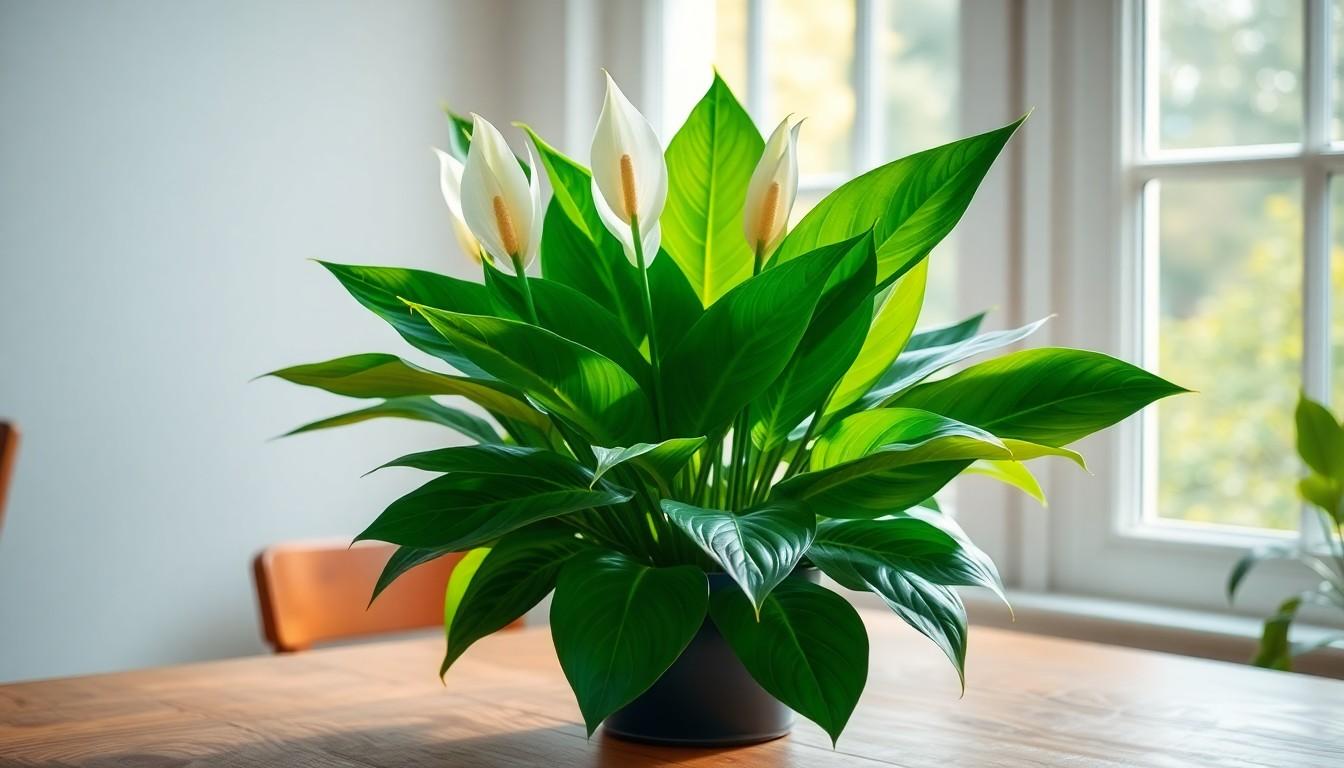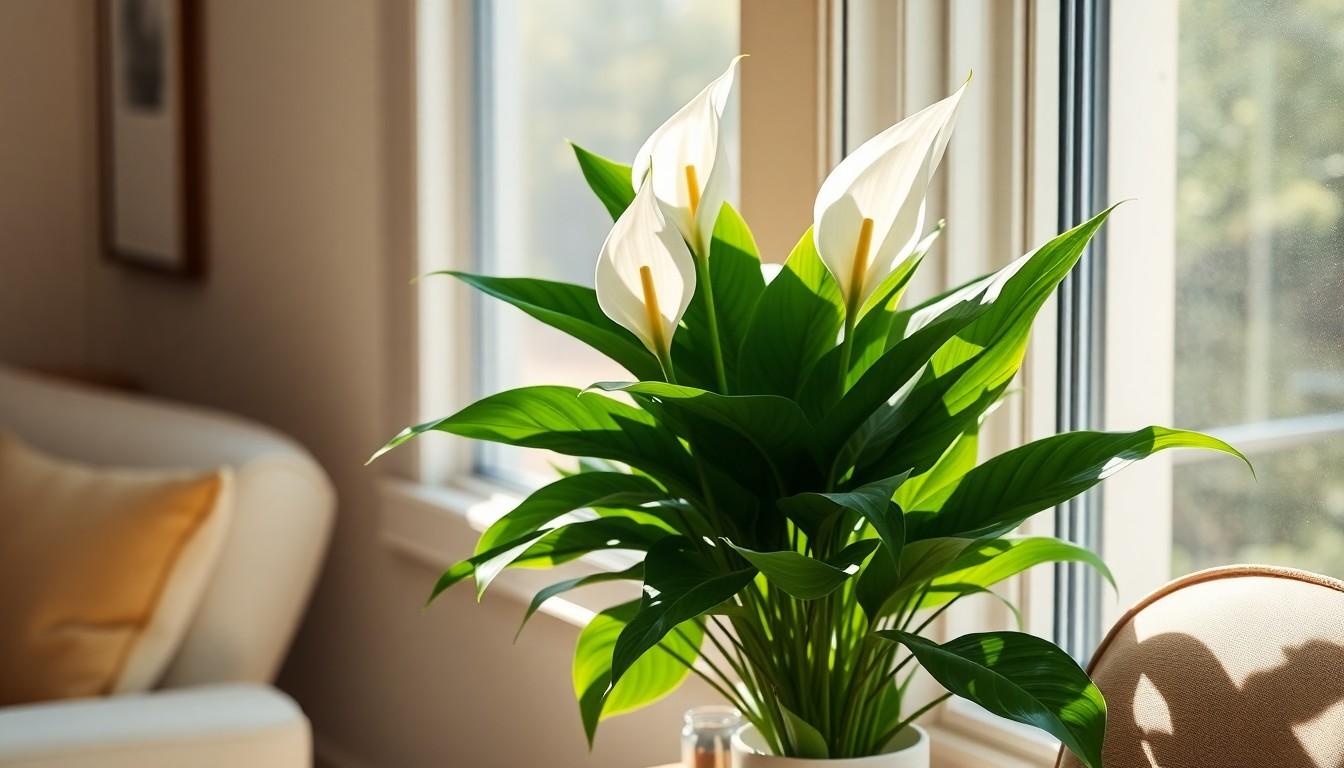Peace lilies are the divas of the houseplant world. With their stunning white blooms and lush green leaves, they not only purify the air but also add a touch of elegance to any space. However, these beauties come with their own set of demands. Neglect them for too long and they’ll let you know—drooping dramatically as if auditioning for a role in a soap opera.
Choosing the Right Peace Lily
Selecting the appropriate peace lily enhances both beauty and health within a home. Consider the following aspects when making a choice.
Types of Peace Lilies
Numerous types of peace lilies exist, each varying in size and flower characteristics. The most common variety, Spathiphyllum wallisii, features lush green leaves and produces elegant white blooms. Smaller options, like Spathiphyllum domino, showcase unique variegated leaves alongside traditional white flowers. Larger types, such as Spathiphyllum mauna loa, can reach up to 4 feet in height, making a bold statement. Each type caters to different aesthetic preferences, helping to create the desired atmosphere in any space.
Factors to Consider
Light requirements impact peace lily growth significantly. Moderate, indirect light fosters robust growth, while low light conditions may lead to sparse flowering. Pot size plays a crucial role, where a well-drained pot supports healthy root development. Water quality is another important factor; troubling elements in tap water can hinder growth. Humidity levels must be moderated; a comfortable level of humidity promotes vitality. Choosing the right peace lily requires careful consideration of these factors to ensure optimal care and flourishing.
Essential Care Tips

Caring for a peace lily effectively enhances its beauty and longevity. Several key factors contribute to maintaining its health.
Watering Requirements
Water peace lilies when the top inch of soil feels dry. Overwatering leads to root rot, while underwatering causes drooping. Typically, these plants thrive with weekly watering. Use room temperature water to avoid shock. During the growing season, increase watering frequency, adjusting based on humidity and temperature.
Light and Temperature Preferences
Peace lilies prefer bright, indirect light, although they tolerate low light. Too much direct sunlight can scorch the leaves. Keep indoor temperatures between 65°F and 85°F for optimal growth. Avoid exposing peace lilies to cold drafts or sudden temperature changes. These conditions stress the plant, leading to poor health and decreased blooming.
Soil and Fertilization Needs
Use a well-draining potting mix for peace lilies, with a blend of peat moss and perlite. Fertilize every 6-8 weeks during the growing season with a balanced liquid fertilizer. Reduce feeding in fall and winter when growth slows. Regular repotting every 1-2 years refreshes nutrients and promotes robust growth.
Common Problems and Solutions
Taking care of a peace lily plant involves addressing common issues that may arise. Understanding these problems ensures the plant remains healthy and vibrant.
Pests and Diseases
Pests can threaten the health of peace lilies. Common culprits include spider mites, mealybugs, and aphids. Regularly inspecting leaves helps catch infestations early. Treatment options include wiping leaves with a damp cloth, applying insecticidal soap, or neem oil for affected areas. Diseases like root rot occur from overwatering, leading to wilting and yellowing leaves. To prevent this, it’s vital to check soil moisture before watering and ensure the pot has adequate drainage.
Leaf Care and Maintenance
Maintaining peace lily leaves proves essential for the plant’s appeal. Dust accumulates on the foliage, blocking light absorption. Gently wiping leaves with a soft cloth keeps them clean and vibrant. Occasionally, dull or brown tips indicate low humidity levels. Increasing humidity through misting or placing a humidifier nearby supports leaf health. Pruning dead or yellowing leaves improves the plant’s energy and encourages new growth. Regular attention to leaf condition ensures a lush, thriving appearance.
Benefits of Keeping a Peace Lily
Peace lilies offer numerous benefits that extend beyond aesthetics. These plants purify indoor air by filtering out harmful toxins like benzene, formaldehyde, and carbon monoxide. Studies by NASA highlight their effectiveness in improving air quality, making them excellent choices for homes or offices.
Another advantage lies in their ability to increase humidity levels. Peace lilies release moisture into the air, which can help alleviate dryness, especially in heated environments during winter months. Increased humidity benefits both respiratory health and skin hydration.
They also contribute to stress reduction. Interaction with indoor plants, including peace lilies, promotes a sense of calm and well-being. Their lush green leaves and elegant blooms add natural beauty, creating a relaxing atmosphere.
Peace lilies require minimal upkeep, making them ideal for beginners. Their resilience allows them to thrive in low light conditions and adjust to irregular watering, which suits busy lifestyles. Regular attention keeps them healthy, but infrequent care won’t cause immediate decline.
Moreover, peace lilies can enhance productivity. Research indicates that having plants in workspaces boosts concentration and efficiency. Incorporating peace lilies into such environments not only elevates aesthetics but also fosters a more productive atmosphere.
In terms of symbolism, peace lilies represent purity and tranquility. They serve as beautiful gifts for expressing sentiments like sympathy or gratitude. Their elegant appearance and meaningful symbolism make them thoughtful additions to any setting.
Overall, peace lilies provide functional advantages alongside their visual appeal and symbolic value.
Conclusion
Caring for a peace lily can be a rewarding experience. With the right attention to light, water, and humidity, these plants can thrive and enhance any indoor space. Their air-purifying qualities and aesthetic appeal make them a popular choice among plant enthusiasts.
Regular maintenance, including checking for pests and ensuring proper drainage, is essential for keeping the plant healthy. By following the care tips provided, anyone can enjoy the beauty and benefits of peace lilies for years to come. Embracing these elegant plants not only brightens a home but also contributes to a healthier living environment.

